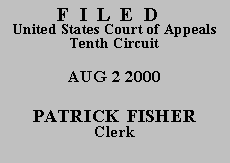 UNITED STATES COURT OF APPEALS
UNITED STATES COURT OF APPEALS
 UNITED STATES COURT OF APPEALS
UNITED STATES COURT OF APPEALS
TENTH CIRCUIT
| UNITED STATES OF AMERICA, | |
| v. | No. 00-2000 |
| ISRAEL CARTER, JR., | (D.C. No. CIV-99-600-JC/RLP)
(D.N.M.) |
ORDER AND JUDGMENT(*)
Before BALDOCK, HENRY, and LUCERO, Circuit Judges.(**)
Defendant Israel Carter, Jr., proceeding pro se, filed a motion a motion to vacate, set aside or correct sentence and conviction pursuant to 28 U.S.C. § 2255. The district court denied the motion and denied Defendant's application for a certificate of appealability. See 28 U.S.C. § 2253(c). We deny Defendant's application for a certificate of appealability as well and dismiss his appeal.
In 1997, a federal jury convicted Defendant of conspiracy to possess cocaine with intent to distribute in violation of 21 U.S.C. §§ 846 and 841(a)(1), and possession with intent to distribute cocaine in violation of 21 U.S.C. §§ 841(a)(1), (b)(1)(B). On direct appeal, we affirmed his conspiracy conviction but reversed his conviction for possession with intent to distribute. United States v. Carter, 130 F.3d 1432 (10th Cir. 1997). Upon remand, the district court sentenced Defendant to 262 months imprisonment. The Supreme Court denied Defendant a writ of certiorari on May 26, 1998.
On May 26, 1999, Defendant filed a motion to vacate, set aside or correct sentence and conviction pursuant to 28 U.S.C. § 2255.(1) In his § 2255 motion, Defendant raised the following three claims: (1) Defendant received ineffective assistance of trial counsel because counsel (a) failed to call the alleged co-conspirator to testify and (b) failed to present an entrapment defense, (2) Defendant received ineffective assistance of appellate counsel because counsel failed to argue that (a) African-Americans were systemically excluded from the venire panel and (b) Defendant could not have conspired with his alleged co-conspirator Anthlia Craft because she was a government informant, and (3) Defendant's rights under the Speedy Trial Act were violated. A magistrate judge entered proposed findings and recommended that Defendant's ineffective assistance claims be denied on the merits and his speedy trial violation claim be dismissed both on the merits and for failure to raise it on direct appeal. After considering Defendant's objections, the district court adopted the magistrate judge's recommendation and dismissed the motion.
Defendant appeals, raising the same claims as he did in the district court. A defendant may appeal the denial of a § 2255 petition only if "a circuit justice or judge" issues a certificate of appealability. 28 U.S.C. § 2253(c)(1)(B). A certificate of appealability "may issue . . . only if the applicant has made a substantial showing of the denial of a constitutional right." Id. § 2253(c)(2). We conclude Defendant has failed to make the required showing.
We have thoroughly reviewed Defendant's application for a certificate of appealability, his brief, the magistrate judge's proposed findings and recommended disposition, the district court's order adopting the magistrate judge's recommendation, and the entire record before us. We conclude that Defendant's claims are meritless substantially for the reasons set forth in the magistrate judge's proposed findings and recommended disposition. Because Defendant has not made a substantial showing of the denial of a constitutional right, we deny his request for a certificate of appealability and dismiss the appeal.
CERTIFICATE OF APPEALABILITY DENIED; APPEAL DISMISSED.
Entered for the Court,
Bobby R. Baldock
Circuit Judge
*. This order and judgment is not binding precedent, except under the doctrines of law of the case, res judicata, and collateral estoppel. The court generally disfavors the citation of orders and judgments; nevertheless, an order and judgment may be cited under the terms and conditions of 10th Cir. R. 36.3.
**. After examining the briefs and appellate record, this panel has determined that oral argument would not materially assist the determination of this appeal. See Fed. R. App. P. 34(a)(2)(C); 10th Cir. R. 34.1(G). The case is therefore ordered submitted without oral argument.
1. In its proposed findings and recommended disposition, the magistrate judge noted that Defendant's motion may have been one day past the one year-limitation period of § 2255. See 28 U.S.C. § 2255 (providing one-year limitation period running from the date on which the judgment of conviction becomes final). Defendant filed his § 2255 motion on May 26, 1999, one year and one day after the Supreme Court denied certiorari on May 26, 1998. See United States v. Willis, 202 F.3d 1279, 1280-81 (10th Cir. 2000) (holding a judgment of conviction is final for purposes of the one-year limitation period in § 2255 when the United States Supreme Court denies a petition for writ of certiorari after a direct appeal). The magistrate judge nevertheless reached the merits of Defendant's motion because the Government did not raise the statute of limitation defense and the answer to the question was not clear. In addition, the magistrate judge noted that we have not decided whether the statute of limitations defense can be raised by the court sua sponte. See Kiser v. Johnson, 163 F.3d 326 (5th Cir. 1999) (holding district court may raise limitation bar sua sponte). Because we agree with the district court's disposition of Defendant's motion and deny Defendant's motion for a certificate of appealability, we, like the district court, do not address the statute of limitations issue. See United States v. Glover, No. 97-5158, 1998 WL 453674, at *1 (10th Cir. Aug. 5, 1998) (unpublished) (noting that one-year limitation period added to the post-conviction statutes by AEDPA is a statute of limitations and, as such, is not jurisdictional).